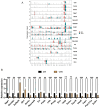Single-Cell Transcriptional Profile Construction of Rat Pituitary Glands before and after Sexual Maturation and Identification of Novel Marker Spp1 in Gonadotropes
- PMID: 38731915
- PMCID: PMC11083676
- DOI: 10.3390/ijms25094694
Single-Cell Transcriptional Profile Construction of Rat Pituitary Glands before and after Sexual Maturation and Identification of Novel Marker Spp1 in Gonadotropes
Abstract
The mammalian pituitary gland drives highly conserved physiological processes such as somatic cell growth, pubertal transformation, fertility, and metabolism by secreting a variety of hormones. Recently, single-cell transcriptomics techniques have been used in pituitary gland research. However, more studies have focused on adult pituitary gland tissues from different species or different sexes, and no research has yet resolved cellular differences in pituitary gland tissue before and after sexual maturation. Here, we identified a total of 15 cell clusters and constructed single-cell transcriptional profiles of rats before and after sexual maturation. Furthermore, focusing on the gonadotrope cluster, 106 genes were found to be differentially expressed before and after sexual maturation. It was verified that Spp1, which is specifically expressed in gonadotrope cells, could serve as a novel marker for this cell cluster and has a promotional effect on the synthesis and secretion of follicle-stimulating hormone. The results provide a new resource for further resolving the regulatory mechanism of pituitary gland development and pituitary hormone synthesis and secretion.
Keywords: SPP1; puberty; rat pituitary; sexual maturity; single-cell RNA sequencing.
Conflict of interest statement
The authors declare no conflicts of interest.
Figures







Similar articles
-
Zebrafish pituitary gene expression before and after sexual maturation.J Endocrinol. 2014 Jun;221(3):429-40. doi: 10.1530/JOE-13-0488. Epub 2014 Apr 7. J Endocrinol. 2014. PMID: 24709578
-
Effects of diethylstilbestrol on luteinizing hormone-producing cells in the mouse anterior pituitary.Exp Biol Med (Maywood). 2014 Mar;239(3):311-9. doi: 10.1177/1535370213519722. Epub 2014 Feb 12. Exp Biol Med (Maywood). 2014. PMID: 24521563
-
Gonadotrophin-inhibitory hormone receptor expression in the chicken pituitary gland: potential influence of sexual maturation and ovarian steroids.J Neuroendocrinol. 2008 Sep;20(9):1078-88. doi: 10.1111/j.1365-2826.2008.01765.x. Epub 2008 Jul 11. J Neuroendocrinol. 2008. PMID: 18638025
-
Gonadotrope plasticity at cellular, population and structural levels: A comparison between fishes and mammals.Gen Comp Endocrinol. 2020 Feb 1;287:113344. doi: 10.1016/j.ygcen.2019.113344. Epub 2019 Nov 30. Gen Comp Endocrinol. 2020. PMID: 31794734 Review.
-
Embryonic development of gonadotrope cells and gonadotropic hormones--lessons from model fish.Mol Cell Endocrinol. 2014 Mar 25;385(1-2):18-27. doi: 10.1016/j.mce.2013.10.016. Epub 2013 Oct 18. Mol Cell Endocrinol. 2014. PMID: 24145126 Review.
References
MeSH terms
Substances
Grants and funding
LinkOut - more resources
Full Text Sources
Research Materials
Miscellaneous

